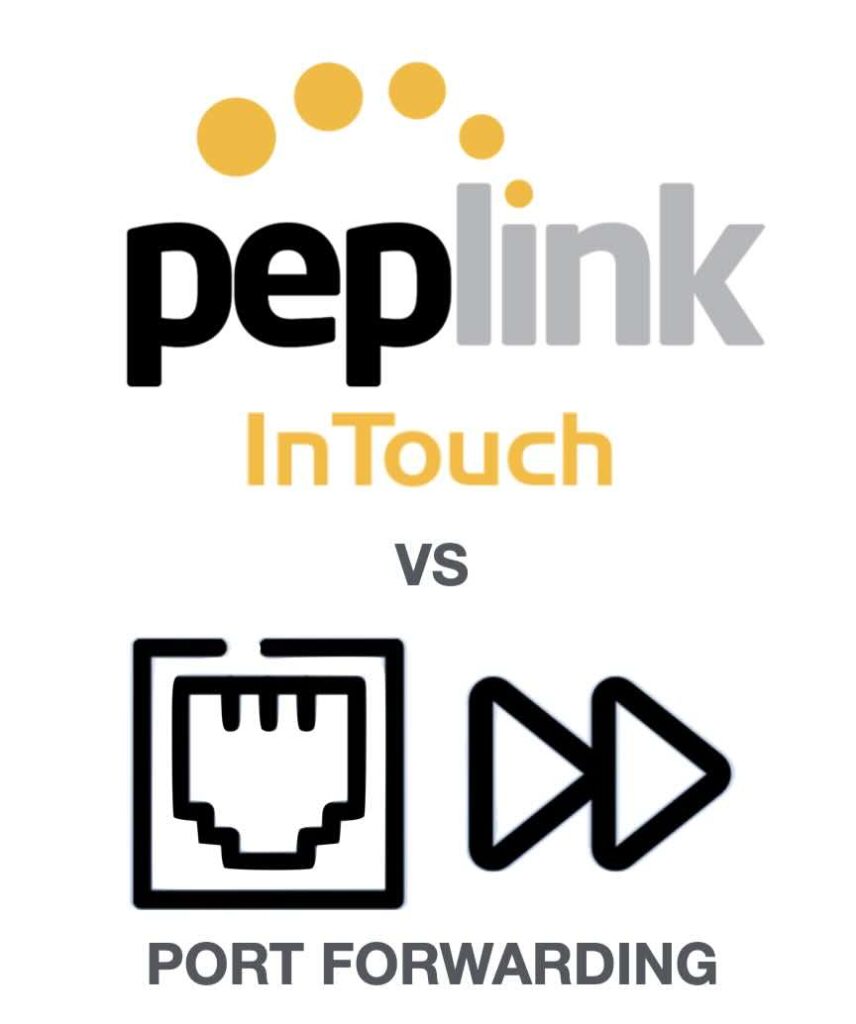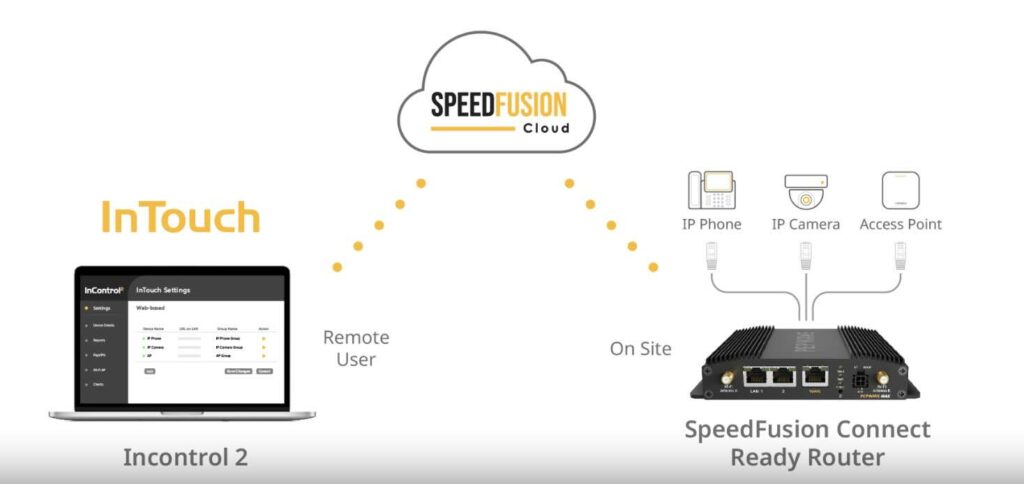
Table of Contents
Remote device management is essential for businesses offering managed services or managing multiple networks and devices across various locations. Two popular methods for enabling remote access are Peplink InTouch or port forwarding, each catering to different needs and setups. In this post, we’ll explore how Peplink InTouch works, break down the mechanics of port forwarding, and compare these approaches. By examining the differences and advantages of InTouch or port forwarding, you’ll gain the insights needed to choose the best solution for your remote management requirements.
What is Peplink InTouch?
Peplink InTouch is a remote device management feature designed for seamless access to IP-based devices connected to Peplink routers. Whether it’s a network camera, IoT sensor, or NAS (Network Attached Storage) device, InTouch allows administrators to securely manage these endpoints via the cloud-based Peplink ecosystem.

For a more in depth setup guide for InTouch see our previous blog post
How It Works:
- Supported Protocols: InTouch allows connectivity to devices on the network that support web interfaces (HTTP/HTTPS) or are reachable via RDP, SSH, Telnet and VNC.
- Cloud Access: Instead of relying on manual routing configurations, InTouch utilizes Peplink’s cloud-based management platform, InControl 2, to easily create secure tunnels between the IC2 session and the device.
- Authentication and Security: Through InControl 2, users must authenticate their access, ensuring only authorized personnel can manage connected devices through the portal.
- Ease of Use: The interface provides a straightforward, centralized dashboard where all devices are accessible without requiring direct IP knowledge or advanced networking setups.
- Cost: InTouch is included with Primecare subscriptions along with IC2 access. You must also have SpeedFusion Connect Protect data to use the feature. SFC data comes with Primecare and can be purchased separately if your initial allotment is used up.
What is Port Forwarding?
Port forwarding is a networking practice that allows external devices to access services hosted on a private network. It works by mapping a specific port on the router’s public IP address to a specific internal IP and port. This lets you remotely connect to devices from outside of your network rather than having to be on the local Wi-Fi or LAN.

For more in depth setup information on port forwarding see our previous blog post
How It Works:
- Router Configuration: Users manually configure the router to forward traffic on a particular port to the desired device IP address within the network. This is done through a port forwarding sub menu within the web admin page of the router.
- Direct Access: The external user must know the public IP address and the correct port number to reach the device or service. Many manufacturers have specific ports that they use for their hardware. In some cases you will need to find unused ports when no recommended ports are provided.
- Security Considerations: Port forwarding exposes devices directly to the internet, which can be a security risk if not properly secured with firewalls, strong passwords, or additional protections.
- Cost: Most routers will have this functionality built in by default. For Peplink routers this feature can be used without any extra licensing cost.
Key Differences at a Glance: InTouch or Port Forwarding?
| Feature | Peplink InTouch | Port Forwarding |
| Ease of Setup | Simple, cloud-based setup through InControl 2 | Manual configuration of router and firewall |
| Security | Secure, encrypted connections via the cloud | Potentially vulnerable to external attacks |
| Access Management | Centralized dashboard for all devices | Access is device-specific, requiring IP/port knowledge |
| Flexibility | Works seamlessly with various device types. Peplink router required | Requires individual setup per device/service. No Peplink router required |
| Scalability | Ideal for managing multiple locations/devices | Can become cumbersome with large setups |
| Static IP Dependent | Does not require a public static IP address | Must have a public static IP address |
InTouch or Port Forwarding: Compare Use Cases
- When to Use Peplink InTouch:
Peplink InTouch is ideal for IT teams managing multiple remote devices across locations. It simplifies device discovery, provides a secure environment, and is highly scalable, making it perfect for large-scale deployments or IoT-heavy networks. - When to Use Port Forwarding:
Port forwarding is suitable for smaller networks, one-off connectivity requirements, or scenarios where cloud reliance is a concern, such as isolated systems with limited internet access. It’s also a go-to method for those familiar with traditional networking setups and willing to invest time in configuration and maintenance.
Examples of Peplink InTouch Use Cases
- Managing Security Cameras Across Multiple Sites: A retail chain with multiple locations can monitor and manage IP cameras without needing static IPs or complex firewall rules.
- Accessing Industrial IoT Devices Remotely: A manufacturing plant uses InTouch to monitor equipment sensors and PLCs (Programmable Logic Controllers) securely from a centralized cloud-based dashboard.
- Supporting Remote Healthcare Clinics: IT teams manage network printers, medical equipment, and connected tablets in remote clinics without physically visiting the location.
- Administering Remote Network Switches: An MSP (Managed Service Provider) uses InTouch to remotely configure Layer 2 and Layer 3 switches in client offices.
Examples of Port Forwarding Use Cases
- Remote Desktop Access (RDP): A user forwards port 3389 to access a work PC from home via Remote Desktop Protocol.
- Accessing a Home NAS (Network Attached Storage): A small business forwards port 5000 to access files stored on a NAS while traveling.
- Hosting a Game Server: A gamer forwards port 25565 to host a Minecraft server for friends.
- Viewing a Single IP Camera: A homeowner forwards port 80 or 554 (RTSP) to view a security camera feed remotely.
- Web Server Access: A developer forwards port 443 to enable HTTPS access to a test web server hosted on their home network.
- Controlling Smart Home Devices: A user forwards port 8080 to access and control a smart thermostat.
- VPN Server Hosting: A business forwards port 1194 for OpenVPN access to their corporate network.
- Accessing a Personal Weather Station: An enthusiast forwards port 3000 to publish data from their personal weather station to the internet.
Choosing the Right Solution: InTouch or Port Forwarding
Deciding between InTouch or Port Forwarding depends on your specific network management needs and infrastructure. If you’re looking for a scalable, secure, and cloud-based solution to manage multiple devices across various locations, Peplink InTouch is ideal, especially for businesses utilizing Peplink routers. Conversely, port forwarding offers a more traditional, cost-effective option for simpler networks or one-off remote access scenarios. By evaluating the strengths and limitations of InTouch or Port Forwarding, you can select the method that best aligns with your requirements and ensures reliable, secure remote access to your devices.
FAQ: InTouch or Port Forwarding
What is the main difference between Peplink InTouch and port forwarding?
Peplink InTouch uses a secure, cloud-based platform for remote device management, while port forwarding relies on manual router configuration to access devices through specific IP addresses and ports.
Do I need a Peplink router to use InTouch?
Yes, Peplink InTouch is a feature available exclusively on Peplink routers as part of the InControl 2 ecosystem, requiring a PrimeCare subscription. Yes, Peplink InTouch is a feature available exclusively on Peplink routers as part of the InControl 2 ecosystem, requiring a PrimeCare subscription.
Is port forwarding secure for remote device management?
Port forwarding can be secure if properly configured with firewalls, strong passwords, and other security measures. However, it inherently exposes devices to the internet, which may increase the risk of cyberattacks compared to encrypted solutions like InTouch.
Which method is better for managing multiple devices across locations?
Peplink InTouch is better suited for managing multiple devices across diverse locations due to its centralized dashboard, scalability, and ease of use. Port forwarding can become cumbersome and less secure in large-scale setups.
Can I use port forwarding without a static IP address?
No, port forwarding typically requires a public static IP address to ensure consistent access to devices. Peplink InTouch, on the other hand, does not rely on a static IP.
Are there additional costs for using InTouch or port forwarding?
Port forwarding is usually a free feature on most routers, but you may have to pay for a public/ static IP address from your Internet Service Provider. InTouch requires a Peplink router, a PrimeCare subscription, and SpeedFusion Connect Protect data, though some SFC data is included with PrimeCare.
Which method is faster to set up: InTouch or port forwarding?
InTouch offers a simpler, faster setup through the InControl 2 cloud platform, while port forwarding requires manual configuration of ports and IP addresses, which can be more time-consuming.
Can I use both Peplink InTouch and port forwarding together?
Yes, if you have specific use cases that require both methods, you can configure your network to utilize both InTouch for secure, centralized management and port forwarding for device-specific access needs.

